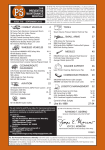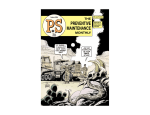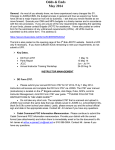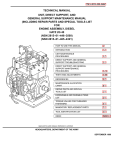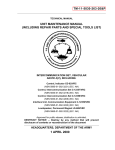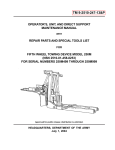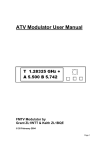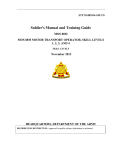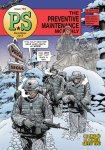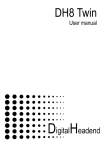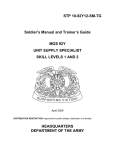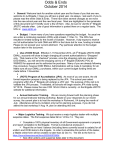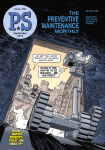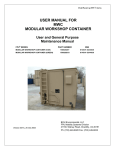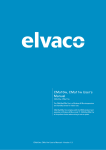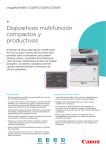Download raymond t. odierno joyce e. morrow combat vehicles 2 10 wheeled
Transcript
TB 43-PS-707, The Preventive Maintenance Monthly, is an official publication of the Department of the Army, providing information for all Soldiers assigned to combat and combat support units and all Soldiers with unit maintenance and supply duties. All information published has been reviewed and approved by the agency responsible for the equipment, publication or policy discussed. Application of the information is optional with the user. Masculine pronouns may refer to both genders. The use of product or company names does not constitute endorsement of those products, services or companies by the U.S. Army. ISSUE 707 OCTOBER 2011 COMBAT VEHICLES 2 Stryker Fuel Leaks M2/M3-Series Bradley Shutdown Reminder M1-Series Tank Brake Levers M113-Series FOV Ramp Safety CVC Helmet Headset Dryness M109 Howitzer, M992A2 Air Box Cleaning M109A6 Paladin Fuel Cap Gasket Check 2-3 3 4-5 6-7 7 8-9 9 WHEELED VEHICLES MRAP/ROUTE CLEARANCE 18 AVIATION Aircraft TMs and Troubleshooting 21 M260/M261 Rocket Launcher Maintenance Tips 22-23 OH-58D Ground Handling Wheels 24 UH-60A Tool Selection 25 AH-64A/D SSU Protection 26 Let PM Prevail TOOLS 27-34 42-43 43 44 CBRN 44-45 CBRN Training Sources Online 46 SOLDIER SUPPORT 46-49 50-51 M978 HEMTT Fueling Safety, Part 1 Fire Extinguisher Information LOGISTICS MANAGEMENT AR 750-6 Revised DA Form 2404 Modifications Power Grid Training Course Improvised Explosive Device Effects Simulator Centrally Managed OCIE PS Magazine Back Issue Retention CALL Handbook CSDP Pointers 51 51 52-53 54-55 56-57 58-59 59 60 61 Connie’s Post Scripts You are invited to send PS your ideas for improving maintenance procedures, questions on maintenance and supply problems and questions or comments on material published in PS. Just write to: MSG Half-Mast PS, the Preventive Maintenance Monthly USAMC LOGSA (AMXLS-GP) 5307 Sparkman Circle Redstone Arsenal, AL 35898 Or email to: [email protected] or [email protected] Internet address: https://www.logsa.army.mil/psmag/pshome.cfm 35 36-37 37 37 38-39 39 40-41 42 Tool Engraving, Part 2 Tool Warranties for Marines 18-19 20 21 35 Small Arms Gaging Requirements Small Arms Cleaning Tank Caution M16A4 Rifle, M4/M4A1 Carbine BUIS Removal M16-Series Rifle Buttstock Correction M120/M120A1, M121 Mortar Tips M249 Machine Gun Barrel Marking M249, M240 Machine Gun Carbon Removal 10 HMMWV Turret Tarp NSNs 10 FMTV Air Springs Inflation 11 HEMTT -A4 Load Testing 12 M1074P/M1075P1 PLS STE-ICE Wiring Harness 13 Lead-Acid Batteries Testing, Charging, Disposal 14-17 Talon 3B Robot Track Adjustment MRAP Rollover Avoidance SMALL ARMS By order of the Secretary of the Army: RAYMOND T. ODIERNO General, United States Army Chief of Staff Official: JOYCE E. MORROW Administrative Assistant to the Secretary of the Army 1120308 PS, The Preventive Maintenance Monthly (ISSN 0475-2953) is published monthly by the Department of the Army, Redstone Arsenal, AL 35898-5000. Periodical postage is paid at the Huntsville, AL post office and at additional mailing offices. Postmaster: Send address changes to PS, The Preventive Maintenance Monthly, USAMC LOGSA (AMXLS-GP), 5307 Sparkman Circle, Redstone Arsenal, AL 35898-5000. Issue 707 TB 43-PS-707 Approved for Public Release; Distribution is Unlimited October 2011 if he survives… he has much to learn about preventive maintenance before facing future enemies! Will he survive? Will he learn? Find out on page 27! Give Equipment A Good Once-Over hey, you’re right from reset and you look great… oh boy! not only does that Black Hawk get to go through reset but it also gets a thorough inspection. if only I was as fortunate. …but I’m going to check you out anyway. TB 43-PS-707, The Preventive Maintenance Monthly, is an official publication of the Department of the Army, providing information for all Soldiers assigned to combat and combat support units and all Soldiers with unit maintenance and supply duties. All information published has been reviewed and approved by the agency responsible for the equipment, publication or policy discussed. Application of the information is optional with the user. Masculine pronouns may refer to both genders. The use of product or company names does not constitute endorsement of those products, services or companies by the U.S. Army. ISSUE 707 OCTOBER 2011 COMBAT VEHICLES 2 Stryker Fuel Leaks M2/M3-Series Bradley Shutdown Reminder M1-Series Tank Brake Levers M113-Series FOV Ramp Safety CVC Helmet Headset Dryness M109 Howitzer, M992A2 Air Box Cleaning M109A6 Paladin Fuel Cap Gasket Check 2-3 3 4-5 6-7 7 8-9 9 WHEELED VEHICLES MRAP/ROUTE CLEARANCE 18 AVIATION Aircraft TMs and Troubleshooting 21 M260/M261 Rocket Launcher Maintenance Tips 22-23 OH-58D Ground Handling Wheels 24 UH-60A Tool Selection 25 AH-64A/D SSU Protection 26 M ost Soldiers are very familiar with the Army’s Reset program that puts equipment back into mint condition. Whether it’s radios, aircraft, tanks or weapons, everything gets torn apart. During Reset, every part of an end item has hands laid on it. Everything is laid bare down to the nuts, bolts, screws and wiring so that the components and hardware can be either repaired, replaced or refurbished. At some point—unlike Humpty Dumpty who couldn’t be put back together again—your equipment is put back together in like-new condition. After it is cleaned, refurbished, and repaired, your equipment is put back in the Army inventory. Because so many things can happen during Reset, it’s a good maintenance practice to do a thorough inspection of equipment that has gone through Reset. For example, on aircraft you might want to look for loose rivets or connectors, FOD, or anything else that could have been mistakenly left behind in areas with moving parts. When you get equipment back from Reset, always take the time to thoroughly perform the PMCS called for in the TM. That way you know your equipment is in mint condition. Let PM Prevail TOOLS 27-34 42-43 43 44 CBRN 44-45 CBRN Training Sources Online 46 SOLDIER SUPPORT 46-49 50-51 M978 HEMTT Fueling Safety, Part 1 Fire Extinguisher Information LOGISTICS MANAGEMENT AR 750-6 Revised DA Form 2404 Modifications Power Grid Training Course Improvised Explosive Device Effects Simulator Centrally Managed OCIE PS Magazine Back Issue Retention CALL Handbook CSDP Pointers 51 51 52-53 54-55 56-57 58-59 59 60 61 Connie’s Post Scripts You are invited to send PS your ideas for improving maintenance procedures, questions on maintenance and supply problems and questions or comments on material published in PS. Just write to: MSG Half-Mast PS, the Preventive Maintenance Monthly USAMC LOGSA (AMXLS-GP) 5307 Sparkman Circle Redstone Arsenal, AL 35898 Or email to: [email protected] or [email protected] Internet address: https://www.logsa.army.mil/psmag/pshome.cfm 35 36-37 37 37 38-39 39 40-41 42 Tool Engraving, Part 2 Tool Warranties for Marines 18-19 20 21 35 Small Arms Gaging Requirements Small Arms Cleaning Tank Caution M16A4 Rifle, M4/M4A1 Carbine BUIS Removal M16-Series Rifle Buttstock Correction M120/M120A1, M121 Mortar Tips M249 Machine Gun Barrel Marking M249, M240 Machine Gun Carbon Removal 10 HMMWV Turret Tarp NSNs 10 FMTV Air Springs Inflation 11 HEMTT -A4 Load Testing 12 M1074P/M1075P1 PLS STE-ICE Wiring Harness 13 Lead-Acid Batteries Testing, Charging, Disposal 14-17 Talon 3B Robot Track Adjustment MRAP Rollover Avoidance SMALL ARMS By order of the Secretary of the Army: RAYMOND T. ODIERNO General, United States Army Chief of Staff Official: JOYCE E. MORROW Administrative Assistant to the Secretary of the Army 1120308 PS, The Preventive Maintenance Monthly (ISSN 0475-2953) is published monthly by the Department of the Army, Redstone Arsenal, AL 35898-5000. Periodical postage is paid at the Huntsville, AL post office and at additional mailing offices. Postmaster: Send address changes to PS, The Preventive Maintenance Monthly, USAMC LOGSA (AMXLS-GP), 5307 Sparkman Circle, Redstone Arsenal, AL 35898-5000. Click here for a copy of this article to save or email. 707 00-01.indd 1-2 9/8/11 4:29 PM Stryker… man, I’m glad to get outTa there! Stop Fuel Leak at Its Source noticed a fuel smell in the crew compartment of your stryker lately? your vehicle could be one of several with a leaking c7 fuel distribution assembly (fda). The majority of the leaks appear at the input and output fittings on the FDA’s check valve. But you also need to eyeball the input and output fittings for the supply and crossover valves. All three of these valves are made of brass and are prone to stress corrosion cracks that let fuel leak out. If enough fuel builds up under the floor plates, you and other crewmembers can be exposed to concentrated fuel vapors that can make you sick. Before you inspect, be sure to drain the hull following the general cleaning instructions in your vehicle’s -10 manual. If no leaks are found, continue your mission. But make sure you check the valves regularly as part of your before-operation PMCS. If you find a leak, tell your mechanic. He’ll contact General Dynamics Land System (GDLS) Contractor Logistics Support (CLS). They’ll send a CLS team to remove and replace the leaking C7 FDA with a new, stainless steel version. PS 707 2 don’t wait around. check it now! Look for leaks around check valve’s input and output fitting yeah! that fuel smell was starting to make me sick! For help locating your GDLS CLS, contact Chris Spall or John Tippett: [email protected] or [email protected] Check out the complete scoop in TACOM GPA 11-011: https://tulsa.tacom.army.mil/safety/gpm/tacom_wn/gpa11-011.html You can also download a complete list of Stryker vehicles with C7 engines by their vehicle identification numbers. Just email Half-Mast: [email protected] M2/M3-Series Bradleys… hey, what’s happened here? my tea leaves tell me you forgot to turn off his electronics and now his batteries are dead. when you shut down, you must remember to… Then check input and output fittings on supply valve… …Make it a COMPLETE Shutdown! T …and crossover valve OCT 11 he mission is finally over and you want to grab a quick shower before heading to the chow hall. But before you crawl out of your Bradley, think a second. Did you remember to turn off the radios? How about the lights and other electronic gear? If you forget, those items can still pull power from the batteries. And if your vehicle sits a while, you might come back to dead batteries. Even worse, you might not notice that the radios were left on. And if you start the engine with the radios on, a power spike could damage them. So don’t forget: A complete shutdown includes all electronics, too. Click here for a copy of these articles to save or email. 707 02-03.indd 1-2 8/29/11 5:34 PM M1-Series Tanks… Go for the Gold I just got a brand new silver-colored remote control lever for my transmission service brake! color matters when it comes to the transmission service brake remote control lever, nsn 3040-01-090-4562, on your m1-series tank. Good levers are gold- or bronzecolored… PS 707 no, that says your service brake might fail! that says I’m stylin’! and no, it’s not because it makes a fashion statement. During the vehicle manufacturing process, workers noticed that some of the levers in their parts bins were silver or aluminum gray rather than the normal gold or bronze color. After the odd-colored levers were analyzed, it was found that they did not meet hardness specifications. …while bad levers will be silver or aluminum gray 4 with Brake Lever OCT 11 better get it replaced! Most of the levers were Look for remote control lever here purged at the manufacturing facility, but it’s possible that a few may have been installed. It’s unlikely the softer levers will break, but a failure would lead to the loss of service brakes. So inspect your tank now. Just open the cooling fan access door on the right side of your tank and look for the lever between the right cooling fan assembly and the exhaust duct. If the lever is gold or bronze, you’re good to go. If a silver or aluminum lever is found, ask your mechanic to replace it. Mechanics, order a replacement lever through normal supply channels using a priority level of 02. To expedite receipt of the replacement lever, overnight shipping is available by contacting the Defense Logistics Agency (DLA) Call Center at 1-877-DLA-CALL (1-877-352-2255) or DSN 661-7766. For OCONUS callers, the DSN is 312-661-7766. To get credit, submit a Product Quality Deficiency Report (PQDR) against TACOM contract W56HZV-07-C-0224. You can start the PQDR process at: http://www.nslcptsmh.csd.disa.mil/webpqdr/webpqdr.htm For more information, check out TACOM GPA 11-014: https://tulsa.tacom.army.mil/safety/gpm/tacom_wn/GPA11-014.html Click here for a copy of this article to save or email. 707 04-05.indd 1-2 8/26/11 3:16 PM M113-Series FOV… Slippery When w et watch that first step! ramp on your M113-series vehicle is made to load and off-load troops quickly and safely. But safety goes out the window if the ramp’s nonslip coating is in bad shape. if the ramp surface on your carrier is down to bare metal, fix it like this… 1. Wash the surface thoroughly with soap and hot water. Use a general purpose scrub brush to remove dirt, grease and loose paint. Rinse with hot water to further cut grease and oil. 2. Let the ramp dry completely. 3. Apply CARC primer to the bare metal surface. Instructions for applying the primer start on Page 8 of TB 43-0242, WD CARC Spot Painting. You’ll find a list of primer NSNs in App B. Depending on the primer you choose, it will need to dry anywhere from 2-6 hours. you can access tb 43-0242 and tm 43-0139 at the logsa etm website: https://www.logsa. army.mil/etms/ Put nonslip walkway compound on ramp’s bare spots it’s a slippery one! T he Footing gets a little tricky when the surface is worn. in wet weather, it can be downright dangerous. 4. Use a paint brush to apply nonslip walkway compound to all the primed areas. NSN 8010-01-527-4055 gets a gallon of tan walkway compound. Instructions for applying the compound start in WP 0010 00-6 of TM 430139, Painting Instructions for Army Materiel. 5. After the nonslip compound has dried, apply a topcoat of WD CARC paint. Application instructions start on Page 9 of TB 43-0242. Choose the type and color WD CARC paint from the list in App B. 6. Allow the WD CARC to dry for at least 6 hours before stepping on it. CVC Helmets… Keep Headset High and Dry I t stands to reason, crewmen: Water and electronics don’t mix. So how you treat the headset in your CVC helmet has a lot to do with how well it works when you need it. If you leave your helmet lying around, it’ll probably get wet the next time you clean your vehicle. The earphones are very sensitive to water. So when the mission’s complete, take your helmet with you or store it in a place where it won’t get wet. PS 707 Stray wash water can seep inside headset earphones 7 OCT 11 Click here for a copy of these articles to save or email. 707 06-07.indd 1-2 8/29/11 5:34 PM M109-Series SP Howitzer, M992A2 Ammo Carrier… Air Box in Need of Cleaning man, that was a {cough!} long mission! my air box could use {wheeze!} a good cleaning! 2. Open the two plugs at the base of each air box and blow out all the dirt and sand with low-pressure air—no more than 30 psi. You’ll have to remove the blower motor hose bracket to get to the plugs on the Paladin’s left air box. Remove plugs and blow out sand and dirt they took care of my air box as soon as we got back! Remove bracket from Paladin air box it makes all the difference! If you don’t keep on top of them, dirt and dust have a funny way of building up fast. A quick look inside the air cleaner boxes in your howitzer or ammo carrier provides all the proof you need. That’s because dust and grit collect all over the boxes even under the best conditions. If you’re deployed, that dirt, sand and dust collect a whole lot faster. When that happens, the air induction system exhaust fans just can’t remove all the dust and grit. So, next time you pull the air filters for cleaning, clean the air boxes, too. after removing the air filter, follow these steps… 1. Clean out any dirt on the panel under the air filter. 3. If the dirt and sand have hardened—which is what happens if water gets mixed in—you’ll probably have to break up the mess with a screwdriver or chisel before blowing it out. Be careful not to damage the bottom of the air box, though. Never clean the boxes by hosing them out with water. That leads to rust, which causes even more clogging problems. M109A6 Paladin… Refueling? CheCk the Gasket! C rewmen, when it comes to the fuel cap on your M109A6 Paladin, it’s all about the seal. Taking the cap off and on, exposure to the elements, and just plain old age take a toll on the rubber gasket on the underside of the fuel cap. When the gasket wears out, it no longer creates a good seal between the fuel cap and the filler neck rim. That can let water and dirt seep into the fuel cells. Check fuel cap gasket And here’s a news flash: The for damage engine won’t burn water or dirt very well. So take a good look at the fuel cap gasket whenever you refuel. If the gasket is torn, cracked or just plain worn out, replace the fuel cap. A new cap comes with NSN 259000-798-4056. PS 707 9 OCT 11 Click here for a copy of these articles to save or email. 707 08-09.indd 1-2 8/29/11 5:34 PM HMMWVs… Turret Tarp NSNs FMTV… Keep Air Springs in PS 699, we gave you NSNs to get replacement tarps for your HMMWV turrets, but those NSNs lead to terminal items, so… drivers, you’re in for a rough ride in your 2 1/2- or 5-ton fmtv if you don’t keep the vehicular air springs inflated. if the cab gets down to metal-to-metal contact, you won’t be a stranger to pain! …we have not just one new NSN for you… A …but two! A 12 x 17 tarp or a fitted cover! Dear Half-Mast, On Page 11 of PS 699 (Feb 11), you recommended that we cover our HMMWV turrets with a tarpaulin, NSN 4610-00-442-9736, to keep rain and snow from flooding inside the vehicle. But FED LOG shows the NSN you gave us is a terminal item. What’s a good replacement? CW2 J.H. Dear Chief J.H., Sorry about that. We’ve got two options for you. NSN 2540-00-587-2532 brings a 12x17-ft tarpaulin. Or you can order a fitted cover with NSN 2540-01-330-6177. PS 707 10 OCT 11 Click here for a copy of this article to save or email. 707 10-11.indd 1-2 few well-intentioned operators believe they have to deflate both air springs before tilting the truck’s cab. Problem is, they forget to re-inflate them when they finish the work. That presents problems. With no air, the cab isn’t level. Bumps and jars during operation can make the springs pinch the bag. A damaged bag won’t hold air, causing your backside to suffer big time on a bumpy road. If the air springs on your truck Keep cab are flat, re-inflate ‘em. The panel’s level with a little misleading. Just press and inflated air turn the CAB knob on the hydraulic springs manifold control panel to the right. There’s only one situation when you need to deflate the air springs, and that’s when you’re preparing your FMTV for air transport. So leave ‘em alone at all other times. Press and And if you have to replace the turn CAB air springs, order them using NSN knob to right 2510-01-481-7663 and NSN 2510to inflate air 01-481-7651. Use your parts manual springs as a guide. Both air springs on basic and –A1 model FMTVs (serial numbers under 100,000) can be repaired by replacing the air bag. To order the air bag, use PN PP997900 with CAGE 26952. An NSN will be assigned later. Cab air bags aren’t on –A1R model FMTVs (serial numbers 100,001 and higher). PS 707 11 OCT 11 Click here for a copy of this article to save or email. 8/26/11 3:16 PM Deflate Suspension Before Load Testing HEMTT -A4s… But sergeant! you TOLD us to load test a crane on a HEMTT -A4. You want your equipment to work, but that doesn’t always happen. And if you’ve tried load testing a crane on your HEMTT -A4, you might have experienced this! Troops have found that load testing a crane on a HEMTT -A4 leads to the suspension air bags inflating and raising the load. This makes it impossible to measure the drift of the load during the test. Avoid this problem by following these updated load test procedures that will be added to your HEMTT -A4 IETM, EM 0288: When you set up the crane, under the “Prepare Crane For Operation” section of the IETM, make sure you dump the suspension air before setting up the outriggers. Go to the “Operator” section of the IETM and find the procedure to “Operate Air Suspension Dump Valve.” Follow those instructions. Once you’ve finished operating or load testing the crane, inflate the suspension after stowing the outriggers. That means the SPNSN AIR LOW indicator light, located to the right of the speedometer and above the transmission oil temperature gauge, should be OFF before you move the HEMTT. This is important because if you Follow IETM instructions for operating operate the HEMTT without the suspension air suspension dump valve inflated, you could damage the truck. PS 707 12 OCT 11 Click here for a copy of this article to save or email. 707 12-13.indd 1-2 M1074P1/M1075P1 PLS… Snub the Rub Hey… what happened to my STE-ICE? it was working a moment ago! he STE-ICE wiring harness on new and rebuilt PLS engines is getting a raw deal. TThat’s because the harness can rub against the rotating back plate of the engine’s 200-amp generator. Enough rubbing wears away the insulation and exposes the wiring. That causes an electrical short in the vehicle’s diagnostic system. A short means no STE-ICE! so here’s the quick fix… Secure wiring harness with zip tie or clamp to engine oil dipstick tube Use a high-temperature tie-wrap, NSN 5975-01-5776742, and secure the wiring harness onto the engine’s oil dipstick tube. That way the wiring harness stays clear of the generator’s back plate. And that’s all it takes to snub out the rub. 13 OCT 11 Click here for a copy of this article to save or email. 8/26/11 3:13 PM Lead-Acid Batteries… wow! LOok at aLl these unserviceable batteries! Saving Good Batteries What do you do when your vehicle’s I’m not unserviceable! lead-acid battery, NSN 6140-01-4851472, doesn’t work? Just turning it in as unserviceable is one choice, but not the right one! The right choice is to test it first to make sure it really is unserviceable. Save your unit the cost of new batteries by testing them when you think they could be bad. Turn them in only when testing shows they are bad. Yeah, me neither! the test equipment you need is in the standard automotive tool set (sats). you can also order individual testers. Testers A conductance tester, such as the Pulse Tech (PT) 490 conductance tester is very sensitive. It can find defects or battery weaknesses long before any problem or capacity loss appears. And the mini battery tester (MBT-1) is a micro-ohm load tester designed as a diagnostic tool for the operator. A fixed post positive connector and coil cord moveable negative connector make checking multiple batteries easy and fast. PT 490 Conductance Tester, NSN 6130-01-510-9594 But the PT 490 can’t analyze the condition of a battery pack if it is connected in parallel; you need to isolate each battery. Use the MDX 700P HD conductance tester. MBT, NSN 6130-01-463-8499 Midtronic’s MDX 700P HD replaces Micro 700 Series conductive tester, NSN 6625-01-477-4704 PS 707 14 OCT 11 Click here for a copy of this article to save or email. 707 14-15.indd 1-2 load testers indicate the battery’s ability to hold its voltage while under load. make sure you read the owner’s manual for load testers before using them. otherwise, you might get incorrect results. PS 707 fully charge the batteries before putting them into service. recharge the batteries after removal if you’re going to store them. you don’t have to recharge the batteries if they are headed to dla disposition services. 15 OCT 11 8/26/11 3:13 PM Chargers here are your charging options… The Pro-4HD charger automatically selects 12 or 24 volts. It senses the battery’s condition and provides only the voltage the battery can accept. It comes with two charging cables: one for the NATO slave connection and one with alligator clamps. The pallet charger is a 12-volt, 12-station charging unit. This charger can connect to any type or size of 12-volt vehicular battery. Each charging station on the charger works independently. That way, any combination of leadacid batteries can be charged at the same time. Pallet charger, NSN 6130-01-532-7711 Pro-4HD charger, NSN 6130-01-500-3401 Pulse Charger World Version Plus, NSN 6130-01-477-4703 Disposal The Pulse Charger World Version Plus is a 12-volt only charger; on the back it has a manual switch for battery types. It comes with alligator clamps, so it should only be used on batteries that have been removed from your vehicle. batteries are considered hazardous material… The Associated PP-1660 Type F charger charges both 12-volt and 24-volt batteries. It has two charging cables: one for the NATO slave connection and one with battery clamps. This charger was issued with the early SATS. Associated PP-1660 Type F charger, NSN 6140-01-518-7866 so make sure you follow hazardous material disposal procedures outlined by the tech manual and state, federal and local host nation laws. also, use da pam 200-1, environmental protection and enhancement, as a resource. you’ll find the hqda guidance in alaract message number 100311741/amhs dtg 031826z may 10. you can search for alaracts on ako. you can also view it online using this link: for more assistance, contact ltc Penny Toniolli. call her at 703-697-0556, dsn 227-0556, or e-mail: penny.toniolli@ us.army.mil https://www.us.army.mil/suite/page/550282 PS 707 707 16-17.indd 1-2 17 OCT 11 8/26/11 3:13 PM Talon 3B Robot… Avoid Loose Track hey! a loose track on your my track is slipping! talon 3b robot is bad news! too much play in the track means it’s going to slip. slippage causes mobility problems on different surfaces and graded slopes. I’m gonna need an adjustment! • With your fingers, loosen the thumb nut counter-clockwise. here’s how to adjust the track… PS 707 • Lift the chassis or turn it on its side so the track is freely suspended. • Using a 5/16-in hex wrench, set the track tension by turning the tensioner screw counter-clockwise until the bottom edge of the small idler wheel is halfway between the track guide lugs. Make sure you check for any movement of the large idler wheel. There should be no lateral (forward and backward movement) of the wheel. • Using your fingers, tighten the thumb nut by turning it clockwise to lock it into position. Do not overtighten the track’s tensioner screw or you’ll shear its cotter pin. Use the same procedure for the other side. How well the robot steers and drives depends on the relative tension between the left and right track. So be sure to adjust each track to the same tension. / Correct track tension adjustment looks like this if you don’t have a 5 16-in hex wrench handy 18 in your tool box… …one is available in a key set that comes with nsn 5120-01-473-9592. OCT 11 Click here for a copy of this article to save or email. 707 18-19.indd 1-2 8/26/11 3:13 PM Avoid MRAP Vehicles… All Aircraft… Rollovers loOk everyone! it’s the troubleshOoter! our hero! to help end vehicle rollovers, keep these lessons learned in mind before you start the day’s mission… he’s gonna take our troubles away! CoOl! he’s here to find our problems! and fix ‘em! • Perform rollover drill rehearsals with the gunner and crew prior to all missions • Keep all mission equipment properly stowed • Maintain appropriate speed for road conditions • Make sure your crewmembers wear seat belts or their Gunner’s Restraint Systems (GRS) • Use a ground guide when tactical conditions permit • Unlock combat door locks in a non-conflict situation. That way, rescuers can enter an unlocked vehicle if needed when planning mission routes using composite risk management, remember that mrap vehicles have larger profiles and weigh more than the vehicles they replaced in theater. also take into account the mission’s criticality, as well as weather and terrain. M echanics, doing a thorough job of troubleshooting prevents the unnecessary replacement of components and parts on your aircraft. If you have problems with a component or aircraft system, troubleshoot it from beginning to end like it says in the TM. This will help you identify exactly what the problem is. It may also help you find faults you can fix without sending components to the support shop. Don’t ignore troubleshooting even when you think it’s a waste of time. Troubleshooting can identify the problem and reduce the hours support needs to spend looking for and fixing a minor problem on a component you turned in as bad. if you don’t troubleshoot thoroughly you’ll end up unnecessarily spending money and replacing parts. So end your troubles by troubleshooting thoroughly like your TMs say. be a hero to your airCrafT… be a TroubleshootEr! PS 707 20 OCT 11 Click here for a copy of this article to save or email. 707 20-21.indd 1-2 PS 707 21 OCT 11 Click here for a copy of this article to save or email. 9/7/11 3:38 PM M260/M261 Rocket Launcher… I’m ready to rock! let’s do some serious rocket firing! ROCK ROCK on on With With RockET RockET Help! Help! your m260/m261 rocket launcher will rock if you remember these rocket tips… Suspect the contacts. If you load rockets in the launcher, but rockets aren’t registering as being loaded, suspect the contacts. Before you spend a lot of time troubleshooting, first try cleaning the contacts in the tubes where the rockets aren’t registering. If the contacts are dirty, the rocket doesn’t have a good electrical connection, which prevents the launcher from knowing the rocket is loaded. Rockets not registering? Clean contacts Mark bad tubes. If troubleshooting does turn up a bad tube, mark out its number immediately on the top of the launcher at each end. That way you will remember which tube is bad and will know not to bother loading a rocket in it again. Tube bad? Mark out its number on launcher Clean with clean bore brush. It is important to clean out the tubes with CLP and a bore brush. Otherwise, dirt and carbon can cause the rockets to jam. But your cleaning won’t do much good if you clean with a dirty bore brush. That just spreads the gunk around. When the brush gets coated with dirt and carbon, give it a good cleaning with soap and water. Let the brush completely dry before using it again. hey, that bore brush is dirtier than me! Use rocket loading tool. Use the tool, NSN 1005-01-536-7961, for loading and unloading rockets. Without the tool, you could jam the rocket in its tube against the rocket stop. Then, when you move the rocket forward to lock it in place, the end shield may be punctured and the igniter wire and weather seal may be damaged. That makes the rocket unusable because of possible exposure to electrostatic discharge and the hazard of electromagnetic radiation (EMR) to ammo and rockets. Use rocket loading tool to avoid damaging… …end shield If you do damage an end shield, contact your ammo logistics/quality assurance representative or turn in the rocket to the ammo supply point. You’re not authorized to replace end shields. now it’s time to rock it! wash it out, will ya? PS 707 22 OCT 11 Click here for a copy of this article to save or email. 707 22-23.indd 1-2 9/7/11 5:44 PM OH-58D… Handling Your WHeEls thanks, buddy! No problem-o! now to take care of your buddy. UH-60A… Use the Right Tool I hopE This wiLl work on the FLOW VALve and not oN my knUCKleS! just don’t leave my gun resting on my pin! that one will work on your nerves and your knuckles and not much else! uSE THis onE! M echanics, Mechanics, your Kiowa Warrior’s ground handling wheels (GHW) should not interfere with its weapons if you install the wheels right. PS 707 Save yourself a headache and possible aircraft damage by lifting the weapon and stowing it in the up position before you install the GHW. Some mechanics know that installing the wheels while the rocket launcher and the M296 machine gun are installed is troublesome. The launcher or other weapon systems get in the way when the wheels are put on the aircraft skids. A common practice is to remove the expandable bolt pin from the universal weapons pylon, lift the weapon, reinsert the bolt pin and then allow the weapon to rest against the bolt pin. That solution has its own problems. The weapon could slip from your hands and bang against the pin. Even if you’re careful and manage to rest the rocket pod or an M296 machine gun on the pin, the pod and gun will eventually bend the pin. And if HELLFIRE missiles are installed, their fins can be damaged by the wheels. When installing the ground handling wheels, it’s best to stow weapons in the up position like it says in Para 4-76 of TM 9-1090-214-23&P. That way you won’t be saying “oops” later. 24 OCT 11 Click here for a copy of this article to save or email. 707 24-25.indd 1-2 using a hammer and an extension to turn off the main module transmission oil flow is not the way to go. The oil filter flow valve positioner tool and a breaker bar are the right tools to use when changing the transmission oil filter on A Model Black Hawks. Make sure the tool is cinched in properly because you’ll need your muscles to turn it. Some mechanics improvise trying to use the old positioner tool with an extension. They end up with busted knuckles, cuts and abrasions, gouges on the transmission sump case and damage to the filter sleeve tang area. Using a hammer and extension or the old tool leads to depot level repairs that may include replacing the filter sleeve or even the transmission. The end result is costly downtime and reduced operational readiness. If you still have the old tool hanging around, don’t use it. It requires brute strength and often slips off, causing damage. Make the tool listed in Fig 264 in WP 2014 00 of TM 1-1520-237-23-20. When changing transmission oil filter… PS 707 …use this tool… 25 …and not this one! OCT 11 Click here for a copy of this article to save or email. 9/7/11 4:50 PM AH-64A/D… Seat Can Damage SSU I hate it when you have to take out my seats. My SSU takes a real beating! I’ll go easy. I won’t yank them out! L ong ago in medieval times, a young squire stands watch… someday I will become a knight… like the one I serve. a light… off in the distance! it is the enemy! don’t Worry! Mechanics, one component in your AH-64 that can’t take a licking and keep on ticking is the sensor surveying unit (SSU), NSN 1270-01-159-7994. Pay attention when removing the co-pilot seat because the sensor Protect SSU when removing seat SSU mounts and the seat are very close. The mounts are not strong and break easily if the heavy seat bangs into them. The SSU sends signals to the integrated helmet and display sighting system (IHADSS). If the SSU is broken, your helmet will no longer be connected to aircraft weapons and the target acquisition designation sight (TADS). If the mounts are broken, it’s over for your bird. It will be red X’d and won’t be flying until the SSU mount gets repaired by a depot maintenance contact team. The pilot seat is less of a problem because there’s more clearance between the SSU and the seat. But, if you’re not careful removing the pilot seat, the SSU can suffer damage there, too. Be careful removing your seats. If you aren’t, the SSU will take a licking and stop ticking. PS 707 26 OCT 11 Click here for a copy of this article to save or email. 707 26-27.indd 1-2 M oments later… now is my chance to earn my knighthood. I will vanquish the foe… by myself! Let “PM” Prevail Click here for a copy of this article to save or email. 8/26/11 3:12 PM S Back in the castle, ighting the enemy, the young squire spurs his steed forward… the young squire slowly regains his senses… so… you are alive, eh? …and discovers he has bitten off more than he can chew. The squire …TOPples him to the ground. fights bravely, but… a sharp blow… 707 28-29.indd 1-2 …I came back bruised and battered. I-I don’t know what to say, sire. I went off to battle seeking victory… instead… The last thing He’s had enough-that will do! PS 707 what do you have to say for yourself? he sees (before HE fades into unconsciousness) is a magnificent knight! 28 OCT 11 th-there were too many— PS 707 h-how do you know-? there was only one! 29 you left the garrison without permission. we could have been over-run…and you, killed. tHe fight was observed. OCT 11 8/26/11 3:12 PM but, there was good reason for your loss in battle squire. what do you mean? “the pommel on your sword was loose.” your skirmish was lost before it began. “the strap on your shield broke.” b-but… how…? “the point on your lance was split.” now tell me… what have you learned from this, young squire? yes…it’s true! all those things did happen. to be prepared before going into battle…and to make sure my equipment is mission ready! and how do you make your equipment mission ready? with maintenance! preventive maintenance could have saved you much suffering. “the strap on your helmet was torn.” PS 707 707 30-31.indd 1-2 read the scrolls in the armory. with preventive maintenance to be exact! verily, sire. “the scrolls contain directions for checks and services to keep equipment ready for battle.” “the horse threw a shoe.” 30 OCT 11 PS 707 31 OCT 11 8/26/11 3:12 PM someday, you will become a great knight. but you have much to learn. this is but your first stop on your journey to knighthood. Time and again his now…get some rest. shield protected him in combat, while his sword vanquished his enemies. F you are inducted into the order of knights. inally, his victories are recognized and he is summoned to be vested as a fullfledged knight. Y ears pass and the squire has applied himself to the proper care and maintenance of his equipment… and has proven his bravery in battle. In the great hall where the knights have gathered… do you have anything to say to your fellow knights? the most important lesson that I have learned is… …the necessity of preventive maintenance! what lessons have you learned? PS 707 707 32-33.indd 1-2 32 OCT 11 PS 707 33 OCT 11 8/29/11 5:34 PM sir knight, you have learned well. take my baTtle shield anD carry it with you always! you are the one with the shield I saw that night so long ago. Small Arms… Where Is the Gaging Requirement? I’m NMC!! hold on! I can’t be fired becAuse I haven’t been gaged in more than a year! Dear Half-Mast, We have weapons in our unit that haven’t been gaged in more than a year. I believe that means they are NMC, but I can’t find where it states that in the TMs. The Soldiers in my unit want to fire the weapons and I can’t prove to them that they shouldn’t. SSG S.G. Dear SSG S.G., Since you are part of an Active Army unit, you are absolutely right: the weapons shouldn’t be fired if they haven’t been gaged in more than a year. Every small arms -23&P TM has this statement: “All Army small arms are to undergo gaging by Direct Support (or equivalent for Aviation units) one year from receipt in accordance with the applicable technical manual. This is NOT a part of initial services to be performed upon receipt of the weapon. Active Army small arms will, as a minimum, undergo subsequent gaging on an annual (every year) basis. Guard and Reserve small arms will, as a minimum, undergo subsequent gaging on a biannual (every two years) basis. These prescribed gaging intervals are, as stated, the minimum required to assure the safety, operability, and reliability of Army small arms. Any small arm may be inspected/gaged on a more frequent basis. It is recommended that weapons used in training be gaged after each training cycle has been completed.” In the M16 rifle’s TM 9-1005-319-23&P, this statement appears at the beginning of the manual after the General Warnings. It’s usually in the same place in the other small arms TMs. PS 707 707 34-35.indd 1-2 34 OCT 11 PS 707 35 OCT 11 Click here for a copy of this article to save or email. 9/7/11 3:38 PM Small Arms… Use Cleaning Tanks with OK - I’m clean now but I neEd to be completeLy lubed before You store me! Caution! no lube means corRosiOn… and corrosion ruiNS me! • Use only dry cleaning solvent Type II (81349), MIL-PRF-680. This is the only solvent authorized for small arms. NSN 6850-01-474-2316 brings 55 gallons, NSN 6850-01-474-2317 5 gallons, NSN 6850-01-474-2319 1 gallon, and NSN 6850-00-281-1985 4 1-gal containers. Units would be better off never using cleaning tanks for their weapons, mainly because it’s too easy to mix up bolts when many weapons are run through the tanks. If a bolt is used with a weapon it wasn’t headspaced for, the receiver can rupture during firing. But cleaning tanks aren’t going away, especially at posts that are dealing with large numbers of weapons during training. Here are a few precautions to help your weapons survive cleaning tanks: • Use a metal basket in the tank to ensure no parts disappear during cleaning. • When the weapons come out of the tank, they must be completely wiped clean of solvent and allowed to completely dry. But here’s the important part: The weapons must then be completely lubricated before storage. Solvent removes every bit of lubrication from weapons. If weapons are stored without being relubed, count on them being ruined by corrosion. • Protect yourself from solvent. It’s strong stuff. Wear goggles, rubber gloves, and coveralls with the sleeves rolled down. • Remember that some weapon parts should never be dunked in solvent. Examples are the M2 and M48 machine gun back plates, the MK 19 bolt assembly and anything plastic. Solvent will eat up these parts. Check the operator TMs for info on what parts to keep away from solvent. M16A4 Rifle, M4/M4A1 Carbine… hands off my buIS, buddy! you gotta leave that installed on me all the time in case those fancy optic sights Stop WORKinG. • Don’t clean small arms in the same cleaning tank you use for things like vehicle parts. They may have contaminants that could damage weapons. dude! you just cleaned HmMwv parts in there… I’m the ONLY solvent you can use on small Arms! PS 707 36 …you’re not putting me in there, too! W hen Soldiers are installing optic sights on their M16A4 rifles and M4/M4A1 carbines, they are removing the backup iron sight (BUIS). Bad move! As its name states, BUIS is the backup sight in case something goes wrong with whatever other sight you’re using. It keeps you from being sightless in the heat of battle. Plus, removing the BUIS deadlines your weapon. So leave the BUIS alone and keep it installed in the rear-most slot on the mounting rail. Install the M68 or RCO-150 sights anywhere but that last slot. That’s strictly for the BUIS. The TMs for the M68 and M150 sights show the sights mounted without the BUIS. That will be corrected in the next update to the TMs. M16 Buttstock Picture Wrong The picture of hte new M16-series rifle hybrid buttstock PS showed on Page 24 in PS 703 (Jun 11) was wrong. When you order the new buttstock kit, NSN 1005-01-569-6938, it will look like the picture on WP 0021-19 in TM 9-1005-319-23&P. OCT 11 Click here for a copy of these articles to save or email. 707 36-37.indd 1-2 BUIS Is Backup... Leave It Alone! PS 707 37 OCT 11 8/26/11 3:09 PM M120/M120Al, M121 Mortars… • If you have an M298 cannon with serial number 11729, Mortar Matters that Matter Here are a few rules all mortar men need to remember about their M120/M120A1 and M121 mortars… • All mortar cannons must have you need to report it ASAP to the TACOM POC at the end of this article. TACOM Safety of Use Messages 10-21 and 10-27 identified several M298s that may be unsafe and only the one marked 11729 has not been accounted for. current Weapons Record Data cards, DA Form 2408-4, prior to firing. Soldiers authorized to fill out the card should make sure their Unit Identification Codes (UICs) are current and show only those UICs that they support or are assigned to. For more information on mortars and UICs, see PS 700: https://www.logsa.army.mil/psmag/ archives/PS2011/700/700-19-20.pdf ah-ha! you’re the infamous 11729. I need to report you. I’m not SURE I UNDERSTAND ALL THis. guess I’d better calL Joe SChmiDT. • The M298 cannon breech cap and cannon tube are a matched-forlife set and shouldn’t be switched between cannons. The breech cap’s firing pin and the cannon’s white line must align for the cannon assembly to lock into the baseplate securely. That’s why they’re matched for life. The serial numbers are stamped on both the breech cap and cannon tube to help you keep track. Breech cap and cannon tube must stay together. Check serial numbers to make sure you’ve got the right ones M249 Machine Gun… • The 120-mm mortar systems with LINs M68405 and M68326 and their M120-mm cannons, NSN 1015-01-5222630, now require Property Book Unit Supply Enhanced (PBUSE) reporting/Unique Item Tracking (UIT). Check with your property book officer for help. 707 38-39.indd 1-2 if you have mortar questions like these guys, contact TACOM’s Joe Schmidt at DSN 786-1216, (586) 282-1216, or email: always A GOod idea for MortaRs. Shipment of Small Arms Equipment, the M298 tube can’t exceed a bore diameter of 4.757 inches for unit deployment or overseas shipment. You can find other info and requirements on 60-, 81- and 120-mm mortars on Pages 48-49 of TB 9-1000247-34. The TB is on the ETM site: https://www.logsa.army.mil/etms/welcom1.cfm 38 you can’t fire Me until you update my 2408-4! joe.schmidt@ us.army.mil • According to TB 9-1000-247-34, Standards for Overseas PS 707 sorry! OCT 11 Click here for a copy of these articles to save or email. Should Both Barrels Be ID’ed? Dear Half-Mast, There is no requirement in the M249 machine gun TMs for both barrels to be ID’ed for the receiver they are headspaced for. Shouldn’t this be an official requirement since it’s critical that Soldiers not use a barrel that hasn’t been headspaced for that receiver? CW4 J.F. Dear Chief J.F., Yes, barrel marking should be an official requirement. This will be added in the next change to TM 9-1005201-23&P. The best way to ID the barrels for both the M240 and M249 machine guns is to safety-wire a dog tag underneath the barrel’s heatshield. Make sure the wire ends don’t stick out where they can poke someone. You can also paint the number on the barrel. What you don’t want to do is engrave the number on the barrel. That ruinsv the barrel’s finish, which leads to corrosion and a ruined barrel. M249, M240 Machine Guns… I think I have carbon congestion! wHoo! I feel Awful! Gas Problems? SCrape ‘em Away! what can I do to hELP? scRApe it OFf! • Clean inside the front of the gas cylinder with the FLAT SIDE I f carbon is allowed to build and build inside the gas systems of the M249 and M240 • Clean the piston grooves by scissoring the SCRAPER around the grooves • Clean the front hole of the piston with the FLAT SIDE machine guns, they fire slower and slower and then not at all. The key to gas relief for both machine guns is the scraper. Each scraper part is designed to scrape away carbon from different parts of the gas system. And the sooner you use the scraper, the easier the job is. The longer carbons sits, the harder it gets. It eventually becomes like enamel. I CAN’T BUDGE THis carbon in your gas system! no wonder! you waited a week to clean it out. you shoulda cleaned me right after firing! Here’s how to use the scraper on both machine guns… • Clean two grooves on regulator with PROTRUDING TIPS • Clean center hole of regulator with POINTED END, turning it clockwise and pushing in until scraper hits bottom PS 707 40 OCT 11 For the chamber, use the chamber brush and CLP. If your M249 or M240 has trouble extracting, a quick cleaning of the chamber usually fixes the problem. CLP does a good job of cleaning off carbon, but it also does a good job of collecting carbon. So never use CLP—or any of the other lubes—on the barrel’s gas regulator hole, the gas regulator, the gas cylinder, or the op rod’s piston end. Clean carbon off those parts with the scraper only—no CLP. Leave M240 set It’s OK to use CLP to clean the barrel, the chamber, the rest at #1 except in of the op rod, and the bolt face, but wipe them dry before firing. emergencies Another excellent way to fight carbon in the gas system is to change the barrel on both the M249 and M240 when you’re supposed to. For the M240, that means changing barrels every 10 minutes during sustained fire (100 rounds per minute) and every two minutes during rapid fire (200 rounds per minute). For the M249, during both sustained fire (40 rounds per minute) and rapid fire (100 rounds per minute), change the barrel every 200 rounds. What you don’t want to do with the M240 is change the gas regulator setting from #1. The #2 setting produces much more carbon in the gas system. The #2 setting should be used only in combat emergencies. If your scraper and elbow grease just won’t clean out all the carbon, ask your armorer for help. Click here for a copy of this article to save or email. 707 40-41.indd 1-2 9/12/11 10:23 AM Tools… in PS 699 (Feb 11), we told you not to engrave ID numbers on Army tools. Tool Tool Engraving Engraving Part 2 Why? Many Army tools have a lifetime warranty, which means they’re replaced for free if they’re damaged or broken. In some cases, engraving or laser etching ID numbers on tools voids that warranty. So that means if something goes wrong with the tool, you could be stuck with the replacement cost. Several readers wrote to PS that you should definitely engrave ID numbers on tools to help keep track of them. One reader pointed out that TC 3-04-7, Army Aviation Maintenance, says: “Paint, etch, tape, or mark all tools for easy identification during inventories.” But, unfortunately, that doesn’t change the fact engraving or etching tools may void their lifetime warranty. One possible solution is to pay the tool’s manufacturer to engrave the ID numbers on the tools. That leaves the warranty in effect. And it turns out some tool manufacturers say it’s OK to engrave or etch the tools without affecting the warranty. So when you’re considering the best hello, way to ID your tools, first check with acme toOls? the manufacturer to see if engraving the do your wrenches tools will affect the warranty. If it will, have lifeTime ask the manufacturer what they charge WaRranties? yes? OK, does for doing the engraving. If that’s more engraving them affect than you want to pay, you’re left with the WArRanty? the alternatives of painting or taping the ID number on the tool. Some units are also putting bar codes on tools. Not sure which of your tool sets have lifetime warranties? PS 655 (June 07) listed many of the sets, kits and outfits (SKO) that have lifetime warranties. You can view the story at: https://www.logsa.army.mil/psmag/archives/PS2007/655/655-28-29.pdf For more current SKO info, go to: https://pmskot.army.mil/ PS 707 42 OCT 11 Replacing Tools Under Warranty If you do break a tool that’s under warranty through normal use, you can usually get it replaced within a couple of business days. Here’s how: • Go to the PM SKOT link on the previous page. • Click on CONTINUE and then on REPLACEMENT/WARRANTY. That brings you to the link that has both tool warranty and replacement links. For a warranty claim, click on the warranty link and enter the requested info. If you need to replace a tool broken through abuse or one that’s been lost or stolen, get it through the replacement process. That way PM SKOT can give you worldwide Army support. Click on the replacement link and enter the tool and credit card or MIPR info. If you don’t have a unit credit card, click on the PM SKOT link for further instructions. If you have tool questions of any kind, call toll free 1-877-4PM-SKOT (1-877476-7568) or email: [email protected] Tool Warranty Often Good for Marines no problem, buddy! my lifetime warranty applies to the marine corps, too! Dear Half-Mast, I have read in PS that many of the Army’s sets, kits and outfits (SKO) have lifetime warranties that will provide replacement of tools that break during normal use. I was wondering if the warranty also applies to tools the Marines purchase through PM SKOT. SFC M.B. Dear Sergeant First Class M.B., Yes, the warranty is good for tools Marines purchase through PM SKOT. But Marines cannot purchase all the SKOs available through PM SKOT. To see which SKOs are authorized for Marines, check USMC Supply Instruction (SI) 10510-OR (publication control number 16410510000), which is online: https://pubs.logcom.usmc.mil/front.htm To obtain tool warranty and replacement info, go to: https://pmskot.army.mil Click on REPLACEMENT/WARRANTY to bring you to the page that has both replacement and warranty links. PS 655 (Jun 07) published a list of many of the SKOs that have lifetime warranties. It’s online: https://www.logsa.army.mil/psmag/ archives/PS2007/655/655-28-29.pdf Click here for a copy of these articles to save or email. 707 42-43.indd 1-2 9/7/11 3:37 PM CBRN Sources I guess you could say that I hear these CBRN training films are kinda old. Good grief! there must be more current training on deconning than this! Dear Half-Mast, We help train Soldiers on CBRN equipment and we’ve run into a couple of problems we hope you can help with: • The only training film we have on deconning is very old. Are there any films more recent? • TC 3-8 used to cover how to conduct gas chamber exercises for masks, but it was rescinded. Its information was supposed to be added to AR 350-1, Army Training, but it wasn’t. Where can you go for guidance on doing the gas chamber exercises? Mr. G.H., You’re in luck! PS 707 G.H. In 2009, a new training video came out on using the M12 decon. You can order it online: http://www.defenseimagery.mil Go to Learning Resources and type in “M12 decon apparatus”. But the Defense Imagery site has a wealth of other training material on all kinds of CBRN and other Army equipment, including the M40 mask, M41 PATS, the ICAM, and the M17 decon. CBRN specialists need to check out the site for material they can use in training their unit. 44 Online OCT 11 CBRN Knowledge Network Concerning your question about info on gas chamber exercises, the US Army CBRN THere’s a whole I’m libRARY here on glad School at Ft Leonard Wood, MO, has put STUFf to help! HalfMASt out instructions for doing the exercises. Go told to their CBRN Knowledge Network site: us about http://www.wood.army.mil/ it! wood_cms/usacbrns.shtml Then click on CBRN Knowledge Network Website. You will need to use your CAC card to log in. Under DOTMLPF, click on Training and click again on CBRN Collective Training. Then click on the file Mask Confidence Training. This gives you a training program developed and approved by the US Army CBRN School. But don’t stop there. The site also offers: • CBRN Specialist (MOS-T) Course (Phase 1) online access instructions • US Army CBRN School Training Support—This site contains training materials used by the school to train CBRN Warfighters. • CBRN Collective Training—This site contains CBRN materials for unit training. • CBRN Soldier Training—This site offers tools, resources and information for Soldier training that includes critical tasks. • Standards in Training Commission—The site assists units in developing weapons training strategies and requirements. Click here for a copy of this article to save or email. 707 44-45.indd 1-2 9/8/11 4:30 PM M978 HEMTT… Get a Safe Handle on Fueling, We’ve put together some guidelines for handling fuel safely… PART I it’s risky business, handling fuel… …open flames, static electricity or sparks can set off fires and explosions… Dress the Part Fuel handlers, make sure you’re dressed for the part by wearing personal protective equipment (PPE)… …liquid fuel can irritate your skin and eyes… • Industrial safety goggles with a seal that holds them snugly against your face. • Fuel handler’s gloves. Size Small Medium Large X-large XX-large NSN 8415-01-5292612 2618 2621 2624 2638 Fuel handler’s glove • Cold weather petroleum handler’s gloves Size …in cold weather, supercooled fuel can inflict frostbite on bare skin. X-small Small Medium Large X-large all good reasons to practice safety when you’re working around your m978 hemtt tanker. PS 707 46 OCT 11 NSN 8415-01475-9987 466-3531 466-3586 466-3587 475-9981 Cold weather petroleum handler’s glove • Hearing protection you’d normally wear in your shop or motor pool. • You might even think about ordering a fire-resistant lightweight performance hood, NSN 8415-01-576-7524. It protects your face, ears and neck. Click here for a copy of this article to save or email. 707 46-47.indd 1-2 9/7/11 3:37 PM PMCS in the TMs Before handling fuel, do the Before PMCS by the book. See Chap 4 of these manuals… You’ll find the TMs on the USAMC Logistics Support Activity ETMs Online website… TM 9-2320-339-10 for the M978A4 TM 9-2320-348-10 for the M978A2 TM 9-2320-429-10 for the M978 https://www.logsa.army.mil/ etms/online.cfm Static Electricity You’ll also find them on EM 0038. One of the greatest dangers around fuel trucks is static electricity. An electrical charge can build up from the flow of fuel through hoses and pumps, and into and out of metal tanks. If the charge becomes too great, it can spark. And that spark might set off a fire or an explosion. That’s why you need to bond and ground your vehicle before handling fuel. Bonding is when you electrically connect two objects to make the static charges on them equal. For example, before you fuel or defuel a vehicle from a HEMTT tanker, connect one of the HEMTT’s static cables to the vehicle being fueled. Grounding is when you electrically connect a single vehicle or two bonded vehicles to a ground rod. In this case, you’d connect one of the HEMTT’s static cables to the rod. Use static cable… Liquid and Vapor Be alert to liquid fuel leaks and fuel vapors around your tanker. 707 48-49.indd 1-2 Fuel leaks do more than waste resources Look at fuel hose for and foul the environment. They’re a fire leaks, holes and tears hazard. A hot engine can ignite leaking fuel. Clothing wet with fuel can catch fire from the static electricity on your body and clothes. Metal scraping pavement causes sparks that can also set fuel ablaze. Inspect the fuel servicing hose for holes, tears or dry rot—prime places where leaks occur. Make sure the fuel service nozzle has a gasket. Inspect it for tears, cracks or dryness. Clean up any leaks you find around your truck. Ask field-level maintenance to replace or repair leaking equipment. See to it your unit has an SOP for fuel leaks and spills. It’s not enough to know the SOP. You need to practice it. Always keep a spill kit on your HEMTT. Make sure the kit has absorbent pads, pillows, socks and dry sweep. One more thing: When you use the fuel service nozzle, put a drip pan under it to catch overflow or drips. Fuel leaks you can spot. Fuel vapors you can’t. You’ve got to sniff them out. Liquid fuel evaporates, forms vapors and mixes with air. It’s especially dangerous in areas that are poorly ventilated. Even an empty fuel tank may still have some lingering vapors mixed with air. Add a flame or spark to the mix and it could explode. …to ground HEMTT Fuel handlers should inspect the static cables and connections daily. Same goes for the ground rod. Static electricity can also build up on Keep water handy to rinse fuel from clothes you and your clothes, especially if they’re nylon or wool. Taking off charged clothes or tugging at them could unleash a spark. If the clothes are wet with fuel, they could burst into flames. (Nylon clothes have another drawback: If they catch fire, they melt.) Keep a 5-gal water can on your truck. You’ll need it if fuel splashes on you. Use water to rinse fuel off your clothes before you strip down. Also use it to flush your eyes and skin as needed. Next month, PS 708 will present the second and final part in this series about safe fuel handling. Part II will discuss night fueling, placards, smoking, sources of ignition, fire extinguishers and education. PS 707 49 OCT 11 8/26/11 3:10 PM Fire Extinguishers… Mission Capable, Strictly Speaking? there’s no fire extinguisher in this guy -is he NMC or not? yes! no! you guys need to talk to someone about this! Half… …mast! The answer’s not as simple as you might think. PS 707 • If the TM lists the fire extinguisher as a basic issue item (BII), it’s required gear. It must be operational and with the vehicle at all times. Otherwise, the vehicle is NMC. It must be deadlined until it gets an operating fire extinguisher. • If the TM includes the fire extinguisher on the no. yes. if your vehicle doesn’t have a portable, handheld fire extinguisher, is the vehicle fully mission capable? According to TACOM, here are the guidelines: PMCS tables in some -10 TMs say the vehicle is nonmission capable (NMC) if its fire extinguisher is missing or not working. PMCS tables in other -10 TMs don’t even mention a fire extinguisher. So how do you know if it’s OK to roll? additional authorization list (AAL), then it’s not required gear. Your vehicle is fully mission capable even if the fire extinguisher is missing or not working. Of course, if your vehicle’s main job is to haul Get a class passengers or flammable materials, you should B and C always carry a fire extinguisher. Get a class B extinguisher and C multi-purpose extinguisher. It’s made for your to put out flammable liquid fires and electrical vehicle equipment fires. Check out your TMs for recommended portable, hand-held fire extinguishers. If the TMs don’t list any, consider one of these: • NSN 4210-01-149-1356 • NSN 4210-01-189-6452 • NSN 4210-01-481-3875 They’re class B and C dry chemical extinguishers that use potassium bicarbonate as an For more information, see TB 5-4200-200-10, extinguishing Hand Portable Fire agent. Each Extinguishers Approved for Users. one has a 5-lb capacity. AR 750-6 Revised 50 OCT 11 A revision to AR 750-6, U.S. Army Equipment Safety and Maintenance Notification System, went into effect in Dec 2010. This rapid revision updates the current command activity names of Army service component commands and direct reporting units. It also assigns responsibility to the Army DCS G-4 to organize and convene an Army Safety Action Team (ASAT) when material risk is determined to be high on any piece of Army equipment, in accordance with AR 385-10, The Army Safety Program. It’s available on the Army Publishing Directorate’s website: http://www.apd.army.mil/pdffiles/r750_6.pdf Click here for a copy of these articles to save or email. 707 50-51.indd 1-2 9/7/11 3:37 PM No Field Days with DA Form 2404 Hey, check out this cool checklist I Made foR DA Form 2404! Dear Half-Mast, DA Pam 750-8, The Army Maintenance Management System (TAMMS) Users Manual, shows examples of how to use DA Form 2404 for PMCS, quarterly inspections, annual services, battlefield damage assessment and repair and estimated cost of damage. My concern is with the proper use of section 10c, “Deficiencies and Shortcomings.” I think only those examples listed should be included in 10c. But I have seen some units turn column 10c into a checklist. For example: “Inspect tank, pump and plumbing for leaks.” Is this permitted? Mr. A.A. Mr. A.A., We’ve received similar inquiries from otHer readers, so this seems to be a common concern. OCT 11 Click here for a copy of this article to save or email. 707 52-53.indd 1-2 improper form modifications include things like changing form FiELD titles. For example, changing the ORGANiZATiON block to read CORPORATiON or moving around the data fields would invalidate the form. it’s a good idea for you to check with the LCMC responsible for the piece of equipment you are servicing. They may already have an approved version of DA Form 2404 you can use that is equipment-specific. CORPORATiON HQDA G-4 tells us a form is not considered altered or modified as long as it’s being used for its intended purpose. For example, if a unit wants to fill in inspection checks or services information on DA Form 2404 and print it locally, that falls within guidelines. PS 707 uhhh… I’m not sure we’re s’posed to tamper with that form. better ask half-Mast. now we can breEze right thROUGH PMCS on this puPpy! For detailed guidance on forms, see DA 25-31, Forms Management, Analysis and Design. Para 1-9 covers steps for getting new forms or modifications approved: http://www.apd.army.mil/pdffiles/p25_31.pdf PS 707 in that case, why reinvent the wheel? 53 8/26/11 3:06 PM Power Grid Training Plugs Safety now there’s a power grid training course that teaches proper installation of the central p0wer solution! electrocutions in theater are happening! these deaths are sad and were preventable. 707 54-55.indd 1-2 the first week of training covers… the second week includes hands-on training with power plants and electrical distribution systems and it covers… • Electrical safety, basic electrical theory, • Grounding and bonding methods • Preventive maintenance checks BB ullets and bombs are not the only threats in a war zone. Something as simple as taking a shower or washing a vehicle can end in tragedy. Several Soldiers have died from electrocution, and others have been injured in power-related incidents. These kinds of tragedies are caused by overloaded circuits, inadequate extension cords or improperly emplaced grounds in the power system. Following safety procedures could have prevented such disasters. Frayed wiring plus overloaded lines equals potential disaster PS 707 It’s easy to assume that when outlets Put are available there is sufficient electricity, safety too. However, the central power solution first by (CPS) was developed to provide tactical learning power grids that supply power to new, right power-hungry technologies. Many way to servicemembers do not know how to set up emplace power grids properly. Proper power installation of power grids can prevent structure electrical fires and save lives. The Communications-Electronics Command-Life Cycle Management Command (CECOM-LCMC) Information Technology Field Service Branch (IT-FSB) Tactical Power Integration Team (TPIT) now offers a 2-week power grid training course that teaches Soldiers how to install the CPS properly. This is important because CPS installation does not currently fall under any military occupational specialty. 54 OCT 11 units of measurement, electrical symbols, Ohm’s Law, electrical math, AC (alternating current) and DC (direct current) circuits, single-phase and 3-phase power, computing neutral current, load calculations and load balancing • Introduction to the National Electrical Code • Sizing of conductors, current draw and voltage drop, circuit breakers and fuses, tools, and use of test equipment (such as multimeters, ammeters and ground resistance testers). and services, safety, paralleling procedures (how to parallel generators to create backup power and uninterrupted power transfer) • Troubleshooting, power plant emplacement, power distribution illumination systems electrical (PDISE) set up, designing and connecting the power grid, and the differences between generator models. This training will be given to some units during rotations to the Joint Readiness Training Center (JRTC) at Ft Polk, LA, or the National Training Center (NTC) at Ft Irwin, CA. However, any unit can request power grid training from CECOM’s IT-FSB TPIT by calling DSN 738-5505, (254) 288-5505, or emailing: [email protected] Click here for a copy of this article to save or email. 8/26/11 3:07 PM Safety… a ncient rome… gratias, brutus cautionus, but I need not fear the Iedes. beware the Iedes! for verily, I heed all the safety warnings in here. However, setting up, handling or breaking down the device without following procedures in the operator’s manual or using the included safety gear is dangerous! The improvised Explosive Device Effects Simulator (IEDES) is a powerful training tool. IEDES was All four “SAFE/ARM” wheels are color-coded with GREEN side for “SAFE” and RED side for “ARMED”. When PSSD is in “SAFE” mode, all 4 wheels should be turned with GREEN indicators facing out NOTE: Wheels are on both sides of PSSD When PSSD is in “ARMED” mode, all 4 wheels should have RED warning indicators facing out [email protected] specially designed to train Soldiers how to defeat explosive devices. PS 707 IEDES kits contain lots of parts, and all of them should be handled carefully. Use extreme caution when handling the Pyrotechnic Scalable Signature Device (PSSD). This 32-shot magazine-based launcher uses M30/M31 cartridges, so handling it without safety gear could result in serious injury to yourself or others. The PSSD should never be powered on or armed during set up, break down, or while loading or unloading cartridges. If the PSSD is detonated while anyone is closer than the required safety standoff distance, it can cause injury from noise, fragmentation and hazardous material. You should find the safety gear needed for handling IEDES in the transit case that was fielded with the device. Both the A-Kit, NSN 6910-01-572-4917, and B-Kit, NSN 6910-01-572-4925, contain specialized face visors, gloves and hearing protection. If some or all of your safety gear is missing, contact your installation’s training safety coordinator to get replacements. When IEDES is first fielded to your unit, a trainer will demonstrate proper handling procedures. However, be sure to read the list of warnings and follow the set up/handling/break-down instructions in the operator’s user manual, OUM-056920-703-10 (Mar 2010). If your your original OUM is missing, contact the IEDES,project project director, Ron Inmon, at DSN 970-3364, 970-3364, (407 ) 208-3364, or email: 56 OCT 11 NOTE: Wheels are on both sides of PSSD Click here for a copy of this article to save or email. 707 56-57.indd 1-2 9/7/11 3:37 PM Logistics Management… Clean Sweep: Commanders Can Move Centrally Managed OCIE Off Books hey, let’s head over to the cIf today and see what’s up! great idea! that’s really where we belong anyway! Reserves Mr. Michael Nixon [email protected] The Army reports that some centrally managed organizational clothing and individual equipment (OCIE) is showing up in PBUSE. Generally, units should not buy or stock centrally managed OCIE issued by Central Issue Facilities (CIFs). Too often, OCIE accountability is lost during change of commands and deployments. Loss of visibility can also mean money down the drain if a unit reorders OCIE it already has. Central Management Office Mr. Amit Saigal [email protected] How Many Back Issues of PS ? many good things come in threes. like chocolate, vanilla and strawberry ice cream! and one of the best trios to keep in your unit is the past three years of ps! • body armor • advanced combat helmets • sleep systems • extended cold weather some examples of centrally managed ocIe that can be transferred off a unit’s property book include… clothing system (ECWCS) articles. The complete list of OCIE that can be transferred from PBUSE to the installation support module (ISM)-CIF contains more than 300 items. Unit commanders, here’s a chance to scrub your property books. You can move centrally managed OCIE out of PBUSE, get it off your unit’s property book and help the Army redistribute supplies. Best of all, moving centrally managed OCIE to your supporting CIF can also free up your unit supply personnel. They’ll no longer have to maintain, manage or account for all these items! PS 707 Note: Before transferring any centrally managed items to your CIF, give them your lateral transfer documentation and set a date for the actual transfer to occur. A lateral transfer is not considered complete until property accountability is transferred to the supporting/gaining CIF, and accounted for in the ISM-CIF. The CIF will transfer OCIE items to the Soldier’s ISM-CIF clothing records. For OCIE items already issued or hand-receipted to a Soldier, transfer the items to the ISM-CIF, then note the transfer in the Soldier’s ISM-CIF clothing record. The Soldier must sign the updated clothing record to finish the transaction. To see the complete list of centrally managed OCIE, with LINs and NSNs, login to AKO: https://www.us.army.mil/suite/doc/25856454 For more information, email the following: Active Army National Guard Lillie Vinson CW4 Kenneth Gildner [email protected] [email protected] 58 S ometimes units ask us how many years of PS Magazine they need to keep on hand. We recommend keeping the last three years, unless your local command says otherwise. if your unit needs back issues of ps, drop half-mast a request at [email protected] be sure to include your full mailing address when you write! OCT 11 Click here for a copy of these articles to save or email. 707 58-59.indd 1-2 9/7/11 3:37 PM Publications… THe CsDP can identify logistical problems and allOW for TiMELY corRective actions… CALL Handbook Gives CSDP Pointers …and help standardize supPly discipliNE and ensure compliance with DA supply policy. Contact Correction for SAMS-E Help On Page 53 in PS 704 (Jul 11), the contact information for the Automated Logistics Assistance Team (ALAT) in Afghanistan Bagram (North) should be: DSN (318) 431-4490/4493 and email: [email protected] Also, the ALAT-Iraq facility closed on September 1, 2011. LOGSA Updates ETM CD-ROM/DVD Labels The USAMC Logistics Support Activity (LOGSA) is updating CD-ROM/DVD labels on all electronic technical manuals (ETMs). Starting September 1, 2011, the new labels will include the current Army Chief of Staff’s name and the signature of the current Administrative Assistant to the Secretary of the Army, which are required on all DA-authenticated technical manuals (paper or electronic format.) The new labels mean it’s no longer necessary to keep the mailers that your disks came in to prove you have official, DA-authenticated CD-ROMs/DVDs. Questions? Contact ETM Customer Service at DSN 645-0809, (256) 955-0809, or email: [email protected] New Fuel Solenoid Diode Assembly for HMMWVs If your HMMWV’s fuel solenoid diode assembly, NSN 596101-180-5634, shorts out, do this. Replace it with the new flyback diode assembly, NSN 5961-01-593-3791. This assembly has a blue protective shrink sleeve; the old one has a black one. You’ll see both assembly NSNs in a future TM change. With the Army’s growing focus on property accountability, it’s more important than ever for each unit to establish and enforce their Command Supply Discipline Program (CSDP). The Center for Army Lessons Learned (CALL) offers a helpful handbook to assist leaders in setting up their unit’s CSDP and reducing fraud, waste and abuse. The Small Unit Leader’s Guide to the Command Supply Discipline Program tells unit leaders how to: M1165A1 HMMWV Windshield NSNs The HMMWV parts manual doesn’t list windshield information for M1165A1 up-armored HMMWVs yet. So use NSN 2510-01-560-1159 to get the driver’s windshield. And NSN 2510-01-561-2540 brings the passenger windshield. Order both with CAGE code 34623. Containerized Kitchen’s Winch, Drum Assembly The NSN, part number and description for the containerized kitchen’s winch, drum assembly, shown as Item 1 in Fig 2 of TM 10-7360-226-13&P (Aug 01, w/Ch 4, Mar 07), are wrong. They’ve changed to: NSN 3950-01-511-1191 Part number 50390-201 Decription PARTS KIT, WINCH The CAGE remains the same. Make a note until the TM is updated. • Implement the CSDP in the unit, step-by-step. • Understand various property types and establish accountability for each type. • Document the loss, damage, or destruction of government property through the FLIPL (financial liability investigation of property loss) process. • Understand maintenance and supply readiness and how it can affect the unit’s ability to perform its assigned mission. To view or download a pdf of the handbook, visit the CALL website: http://usacac.army.mil/cac2/call/docs/10-19/10-19.pdf PS 707 60 OCT 11 Click here for a copy of these articles to save or email. Click here for a copy of this article to save or email. 707 60-61.indd 1-2 8/26/11 3:06 PM Click here for a copy of this article to save or email. DON’T FORGET YOUR SAFETY GOGGLES! …can change quickly!


































